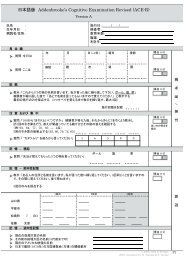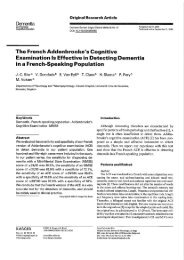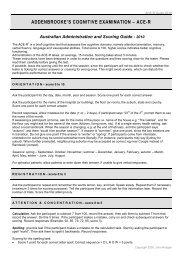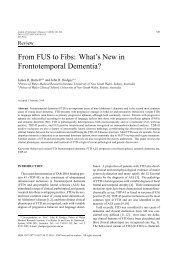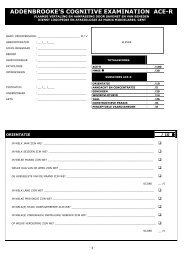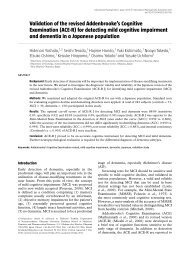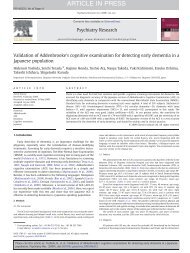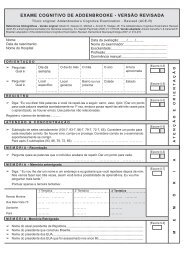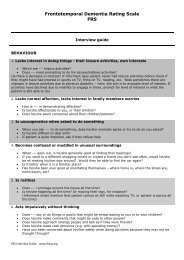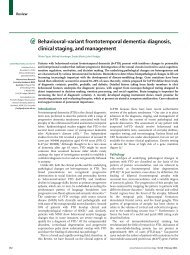Neurocase The Cambridge Semantic Memory Test Battery ...
Neurocase The Cambridge Semantic Memory Test Battery ...
Neurocase The Cambridge Semantic Memory Test Battery ...
Create successful ePaper yourself
Turn your PDF publications into a flip-book with our unique Google optimized e-Paper software.
Downloaded By: [University of New South Wales] At: 01:21 23 April 2010<br />
NEUROCASE<br />
2010, iFirst, 1–15<br />
= NNCS<br />
<strong>The</strong> <strong>Cambridge</strong> <strong>Semantic</strong> <strong>Memory</strong> <strong>Test</strong> <strong>Battery</strong>:<br />
Detection of semantic deficits in semantic dementia<br />
and Alzheimer’s disease<br />
<strong>Cambridge</strong> <strong>Semantic</strong> <strong>Memory</strong> <strong>Test</strong> <strong>Battery</strong><br />
Anna-Lynne R. Adlam, 1 Karalyn Patterson, 1 Sasha Bozeat, 1<br />
and John R. Hodges 1,2<br />
1 MRC Cognition and Brain Sciences Unit, <strong>Cambridge</strong>, UK<br />
2 Prince of Wales Medical Research Institute, Randwick, Sydney, New South Wales<br />
<strong>The</strong> aims of this study were (a) to explore the utility of, and make more widely available, an updated and extended<br />
version of the <strong>Cambridge</strong> <strong>Semantic</strong> <strong>Memory</strong> test battery, and (b) to use this battery in conjunction with other tests<br />
to characterise the profile of several different forms of progressive cognitive impairment: semantic dementia (SD,<br />
n = 15), mild cognitive impairment (MCI, n = 7), established Alzheimer’s disease (AD) (n = 8), all in comparison<br />
to normal controls (n = 45). <strong>The</strong> semantic battery is useful in a variety of ways for exploring the nature of<br />
semantic deficits; on its own, however, it does not provide sensitive differentiation between patients with AD and<br />
SD. An assessment including measures of episodic memory and visuospatial abilities as well as the semantic battery<br />
is recommended for good characterisation of the cognitive profiles associated with SD and AD.<br />
Keywords: <strong>Memory</strong>; Neuropsychology; <strong>Memory</strong> disorders; Dementia; <strong>Semantic</strong> Dementia; Alzheimer’s disease.<br />
INTRODUCTION<br />
Previously we have reported a battery of neuropsychological<br />
tests used within our clinic (e.g., Hodges,<br />
Salmon, & Butters, 1990; Hodges, Patterson,<br />
Oxbury, & Funnell, 1992a; Hodges & Patterson,<br />
1995; Hodges et al., 1999) to assess semantic memory,<br />
episodic memory and other aspects of cognitive<br />
processing. Here, we describe the full battery of<br />
tests, including a newly devised measure of associative<br />
semantic memory (the Camel and Cactus<br />
<strong>Test</strong>), and compare the performance across different<br />
patient groups (<strong>Semantic</strong> Dementia, Mild Cognitive<br />
Impairment, and Alzheimer’s disease).<br />
<strong>The</strong> <strong>Cambridge</strong> <strong>Semantic</strong> <strong>Memory</strong> (CSM) test<br />
battery is a collection of tests that use the same set<br />
of stimulus items to assess semantic knowledge<br />
systematically across different input and output<br />
modalities. <strong>The</strong> original version consisted of 48<br />
items, half living and half manmade, which were<br />
not well matched for familiarity or age of acquisition,<br />
factors known to have a significant influence on<br />
performance (Barry & Ellis, 1997; Funnell, 1992;<br />
Stewart, Parkin, & Hunkin, 1992). <strong>The</strong> updated<br />
battery contains 64 items representing three subcategories<br />
of living things (animals, birds and fruit)<br />
and three sub-categories of artefacts (household<br />
items, tools and vehicles). It was not possible to create<br />
a single set of items matched across living and<br />
manmade categories for both concept familiarity<br />
and age of acquisition, so two stimulus subsets<br />
were assembled, each consisting of 16 living and 16<br />
We thank the participants and their families for their continued support with our research. This research was funded by the Medical<br />
Research Council (MRC).<br />
Address correspondence to Professor John R. Hodges, Prince of Wales Medical Research Institute, Randwick, Sydney, New South<br />
Wales, 2031, Australia. (E-mail: j.hodges@powmri.edu.au).<br />
© 2010 Psychology Press, an imprint of the Taylor & Francis Group, an Informa business<br />
http://www.psypress.com/neurocase DOI: 10.1080/13554790903405693



